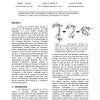Free Online Productivity Tools
i2Speak
i2Symbol
i2OCR
iTex2Img
iWeb2Print
iWeb2Shot
i2Type
iPdf2Split
iPdf2Merge
i2Bopomofo
i2Arabic
i2Style
i2Image
i2PDF
iLatex2Rtf
Sci2ools
RECOMB
2002
Springer
2002
Springer
A dimensionality reduction approach to modeling protein flexibility
Proteins are involved either directly or indirectly in all biological processes in living organisms. It is now widely accepted that conformational changes of proteins can critically affect their ability to bind other molecules and that any progress in modeling protein motion and flexibility will contribute to the understanding of key biological functions. However, modeling protein flexibility has proven a very difficult task. Experimental laboratory methods such as X-ray crystallography produce rather few structures, while computational methods such as Molecular Dynamics are too slow for routine use with large systems. A medium sized protein typically has a few thousands of degrees of freedom. This paper shows how to obtain a reduced basis representation of protein flexibility. We use the Principal Component Analysis method, a dimensionality reduction technique, to transform the original high dimensional representation of protein motion into a lower dimensional representation that cap...
Computational Biology | Dimensionality Reduction Technique | Key Biological Functions | Principal Component Analysis | RECOMB 2002 |
Related Content
| Added | 03 Dec 2009 |
| Updated | 03 Dec 2009 |
| Type | Conference |
| Year | 2002 |
| Where | RECOMB |
| Authors | Miguel L. Teodoro, George N. Phillips, Lydia E. Kavraki |
Comments (0)

